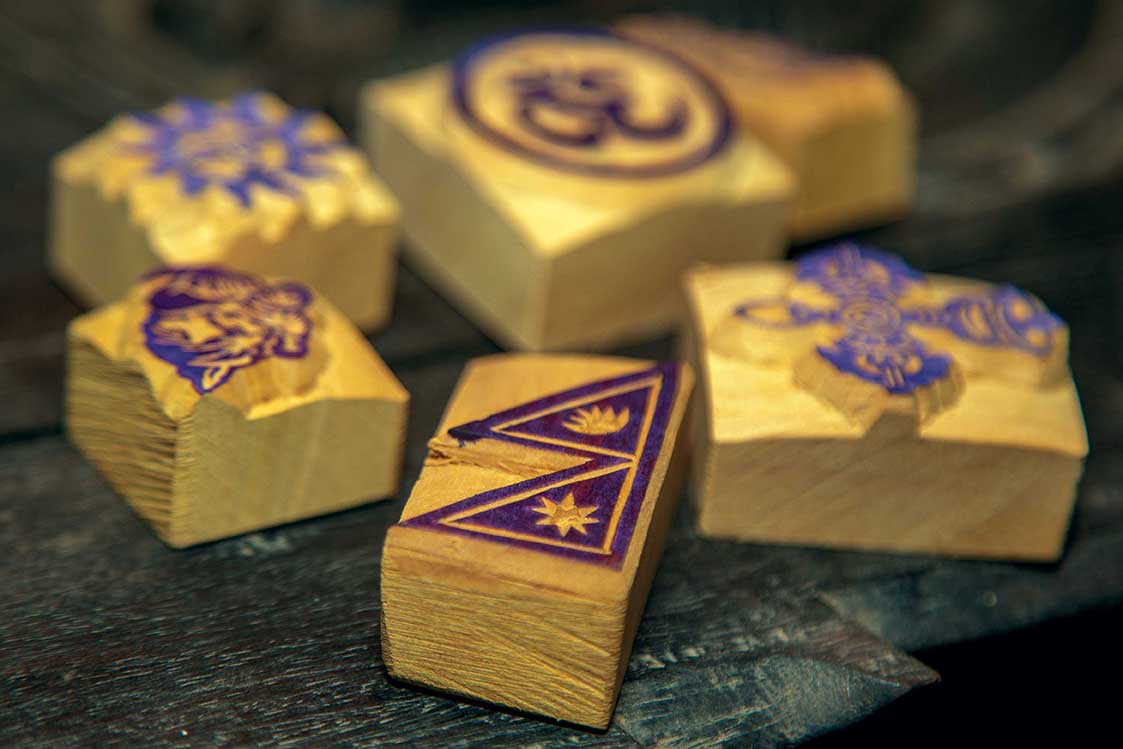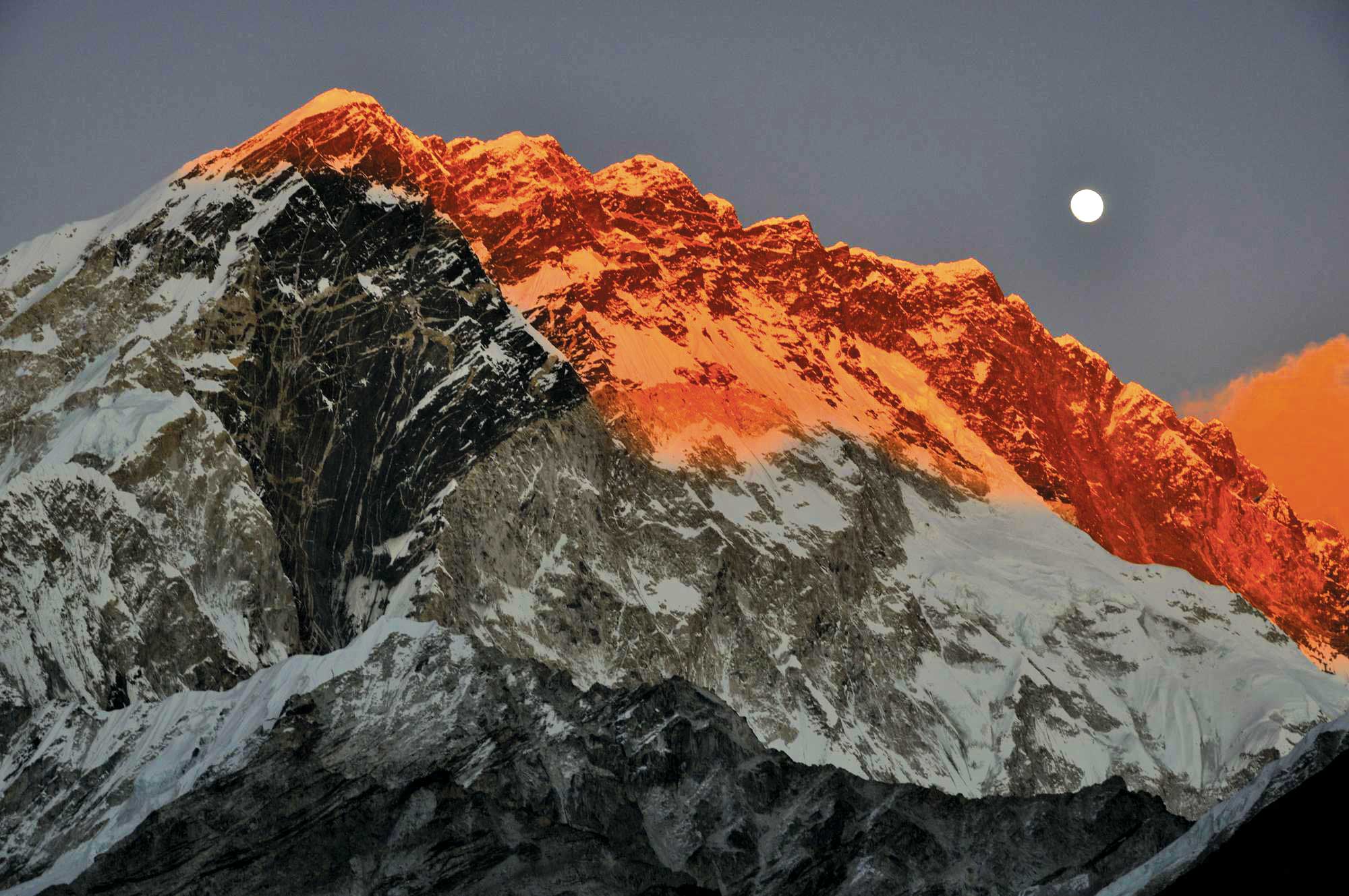Short, stubby and well-formed, the khukuri is an apt reflection of the typical persona of the legendary Gurkha soldier. And, like the Gurkha soldier who looks so compatible in photos but becomes so very dangerous in war, the khukuri too might look great as a wall piece, but can be deadly in battle.
The weapon has never lost its sheen from the time of its first recorded use during the war Prithvi Narayan Shah and his Gorkhali army fought in their bid to unite the many small kingdoms within what is now Nepal. Immediately afterwards, it was the British forces that bore the brunt of the khukuri’s wrath.
 The bravery of Gurkhas to a great extent can be credited to the khukuri. A gun-carrying soldier can sneak and hide to take a shot at his enemy, but a khukuri-wielding Gurkha has to take a jab at his enemy from arm’s length. So, for enemy soldiers, the khukuri-wielding Gurkhas charging after them, with their naked khukuris raised in the air, shouting “Aayo Gorkhali,” must seem quite a specter, almost like messengers of death. Many a time, this specter has been enough to prompt enemies to abandon their posts and run for their lives!
The bravery of Gurkhas to a great extent can be credited to the khukuri. A gun-carrying soldier can sneak and hide to take a shot at his enemy, but a khukuri-wielding Gurkha has to take a jab at his enemy from arm’s length. So, for enemy soldiers, the khukuri-wielding Gurkhas charging after them, with their naked khukuris raised in the air, shouting “Aayo Gorkhali,” must seem quite a specter, almost like messengers of death. Many a time, this specter has been enough to prompt enemies to abandon their posts and run for their lives!
You must have heard many highly romanticized stories related to the khukuri. But there are also several anecdotes you might not have heard that illustrate the exploits of khukuri. Once, people closely related to this writer, were travelling in India on a pilgrimage. While they were inside a fully packed train compartment, a man rushed forth pushing everybody aside. He was in a hurry to relieve himself, apparently his bladders were full. “Are hato bhai, bathroom jayega.” (Give way, I want to use the bathroom). This man made his way forward inside the packed compartment without concern or care for anybody’s convenience that made people bump around and step on each other. Already pestered by overcrowding, one particular relative of this writer lost his patience and shouted, “Ko ho yo bhutrung jayega bhandai thelne? Aye sainla le le khukuri aja chhapkai diyun esko bhutrung.” (Who is this pushing around and shouting ‘bhutrung’ jayega? Oh brother, give me my khukuri and I’ll chop off his ‘bhutrung’.) “Bhutrung”, distorted to sound like bathroom, also indicates private body parts in colloquial Nepali. Sure, the jerk didn’t want his ‘bhutrung’ chopped off! He was out of the compartment in a flash!
But anecdotes aside, hold a khukuri in your hand and you are bound to feel adrenaline pulsing in your throat. No kidding, try it. It is not like gun that you get hold of and then keep it in your pocket. The first instinct when you hold a khukuri is swinging and swaying it, as if to release the rush of adrenaline you immediately feel. Guns make you feel protected, khukuri makes you feel powerful. However, out in the wild, the use of khukuri is not just limited to killing and protecting. There is a diverse array of tasks that it can accomplish. Any tool designed to tackle one challenge might not come handy in dealing with others. The khukuri, however, is designed to break this mold by excelling at a variety of heavy and finer work.
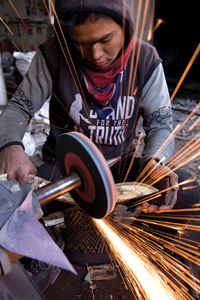
The making of the legendary khukuris
Construction
Since khukuris aren’t made following any standard specification, the shape, size and weight varies from one maker to the other. The basic design that immediately distinguishes khukuri from other knives, however, remains the same. One study, for example, suggests that the center of gravity that is at 2.5” (6.4cm) in front of the bolster helps the blade gain momentum while being swung. The blade’s distinctive forward curve, on the other hand, tremendously increases chopping power as compared to a straight blade. Finally, the convex profile of the blade and the angular slant with which the target is struck increases the cutting ability of the blade that slides across as it pushes through. There is no particular brand of khukuri that can be considered to have benchmark specifications. The quality of khukuri depends mainly on the type of metal being used, a piece of high-grade steel chucked out from a chunk of railway track or springs of discarded cars and trucks. The khukuri blades vary in quality as both inferior and high quality steels are used. Thus an expert eye and skill are required to distinguish the right kind of metal.
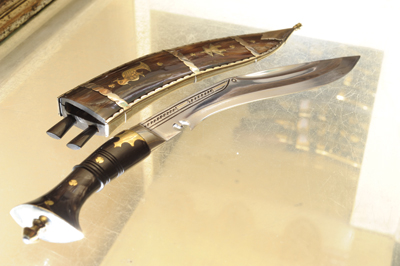 Notch or Cho
Notch or Cho
Though very small and generally considered to be of less significance, the notch in the blade, directly in front of the grip and the bolster, is a very important part of the khukuri. The notch, also called ‘cho’, separates the khukuri from other knives and arouses much interest because of its unique shape and its supposed utility. Practically, the notch keeps the blood or fluid from dripping over to the hilt thus ensuring a firm grip at all times. It also works as a stopper and prevents ‘chakmak’ (the sharpening tool) from reaching the handle area as it is being run down the edge of the blade while sharpening. Similarly, the notch also has religious significance as it is always in the shape of the Hindu fertility symbol (Om). It is also believed to have been developed as a device for catching and neutralizing an enemy blade in close combat. The first khukuri blade ever known to modern mankind had the cho and some drawings found in an Indian temple around 600 AD also depict it in the blade. Almost all khukuris that originated in the past had the legendary notch and even the modern ones continue to carry this distinctive tradition.
 Grip
Grip
Khukuri grips are normally made from local walnut wood called ‘sattisal’. Some use rhododendron wood while other types of grips may be made of animal horns, mainly water buffalos’. More fancy ones use brass and aluminum and even ivory and rhino horn to make the khukuri look special. Most of the ancient khukuris, however, had wooden handles. Though khukuris are improvised to better suit the demands of today, the makers of khukuris still follow the traditional method. It is claimed that a khukuri assembled in the traditional manner has never broken in combat.
Scabbard
The khukuri is carried in a scabbard, “Dap” in Nepali, where normally two pieces of wooden frames are covered with water buffalo hide or refined leather extracts from other domesticated animals. The scabbard, like the blade and handle, has come a long way with many changes and modifications. Some khukuris have decorative scabbards with beautifully well done wooden, horn, silver or brass work and sometimes ivory. Khukuris that are especially intended for display are given extra time and effort to decorate the scabbards using expensive decorative materials and crafting beautiful designs with traditional and religious symbols. The khukuri scabbard has two pockets at the back that carries a blunt steel called ‘chakmak’ for sharpening the blade, and a little sharp knife called ‘karda’ that is used as a small utility knife.
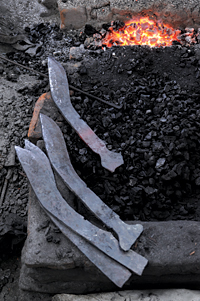 Types of Khukuris
Types of Khukuris
In Nepal, the different types of khukuris go by the name of the place where they are manufactured or by what they are locally referred to by people who make and use them. For example, khukuris made in the eastern village of Bhojpur take the name of the place and are called ‘Bhojpure’ khukuris. Bhojpure khukuris are very thick and relatively heavier than other khukuris. On the other hand, another type of khukuri is called ‘Sirupate’ because it is very slim and thin just like the leaves of a certain plant. Similarly, khukuris made in Dhankuta and Chainpur are also popular and called Dhankute and Chainpure khukuris respectively. As all local khukuris are handmade, therefore, even the khukuris made in the same district by the same people tend to differ from one another, making it impossible to characterize or distinguish a particular khukuri from the rest. Each khukuri, however, bears some impression that an experienced person can identify as the hallmark of the maker and the region where the weapon is made.
Major portion of the article is adapted from www.khukurihouseonline.com.



